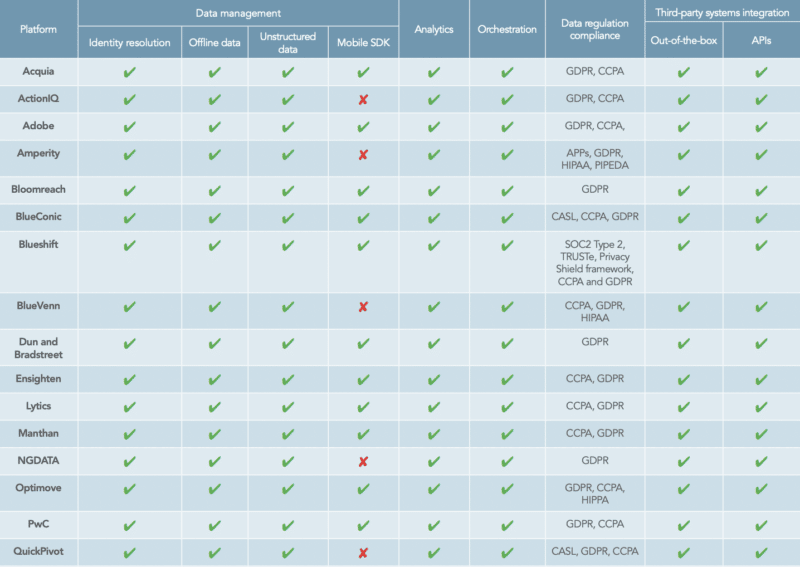Data is the lifeblood of high-functioning marketing organizations, which explains why customer data platforms are so hot right now. CDPs serve as the “single source of truth” for the profiles of known and anonymous individuals. CDPs also unify and normalize first-party customer data, improving data accuracy, targeting relevance and marketing campaign velocity. Lastly, CDPs put control of marketing data and technology in marketers’ hands and facilitate compliance with the growing array of data privacy regulations through strong data governance.
So when it comes time to purchase or upgrade a CDP for your organization, the demo can be the best way to really understand what a particular vendor offers.
For starters, set up demos within a relatively short time frame of each other to help make relevant comparisons. Also, make sure that all potential users and stakeholders are on the demo call, and pay attention to the following: How easy is the platform to use? Does the vendor seem to understand our business and our marketing needs? Are they showing us our “must-have” features?

Explore platform capabilities from vendors like Blueconic, Tealium, Treasure Data and more in the full MarTech Intelligence Report on customer data platforms.
“We’ve seen the most success with the RFPs that we have managed on behalf of clients by defining detailed use cases that force the vendors to demonstrate some of the capabilities that are critical for the organization as part of their demos,” said Craig Howard, solutions lead and key architect at Merkle. “This also helps the vendors have the best chance for success and removes a lot of ambiguity around key requirements.”
Top help you navigate the demo, here are a few questions to ask each vendor:
- How does the platform provide identity resolution? How does it stitch data pointsn together?
- How does the platform handle both structured and unstructured data?
- How does the platform ingest and manage offline data?
- How does the platform monitor integration success and/or failures, and report on data variances or anomalies?
- How does the platform handle connectors and integrations with outside martech systems?
- Are your “must have” integrations rock solid?
- What is the CDP’s approach to integrating with the specific martech systems that your company uses? Just because a connector exists doesn’t mean it will necessarily work for your organization and how you use that third-party platform.
- How does the platform allow users to create customer segments based on behaviors and preferences?
- How does the platform employ machine learning for data analytics, such as predicting customer trends and patterns?
- How can we send personalized and targeted messaging from the CDP?
- How can we use the CDP to coordinate and track multi-step marketing campaigns?
- What data security regulations does the platform comply with?
- What data security certifications does the platform have?
- Can we pay the software license month-to-month? Or is an annual contract required? Is there a short-term contract or an “out” clause if things don’t work out?
- Will there be a price increase when I renew next year — if so, how much? Will the vendor commit to capped increases over a period of years?
- What are the additional fees? (i.e., set-up costs, add-on features, API, quotas)?
- How long is the onboarding process typically? Will we have a dedicated resource? Who will be the day-to-day contact?
- What is the level of support included in the price? What support is additional?
- Who pays if your system/team makes an error?
- Will our support team work with us to test new features and assess the results?
Get the daily newsletter digital marketers rely on.
Customer data platforms: A snapshot
What they are. Customer data platforms, or CDPs, have become more prevalent than ever. These help marketers identify key data points from customers across a variety of platforms, which can help craft cohesive experiences. They are especially hot right now as marketers face increasing pressure to provide a unified experience to customers across many channels.
Understanding the need. Cisco’s Annual Internet Report found that internet-connected devices are growing at a 10% compound annual growth rate (CAGR) from 2018 to 2023. COVID-19 has only sped up this marketing transformation. Technologies are evolving at a faster rate to connect with customers in an ever-changing world.
Each of these interactions has something important in common: they’re data-rich. Customers are telling brands a little bit about themselves at every touchpoint, which is invaluable data. What’s more, consumers expect companies to use this information to meet their needs.
Why we care. Meeting customer expectations, breaking up these segments, and bringing them together can be demanding for marketers. That’s where CDPs come in. By extracting data from all customer touchpoints — web analytics, CRMs, call analytics, email marketing platforms, and more — brands can overcome the challenges posed by multiple data platforms and use the information to improve customer experiences.
Source link




